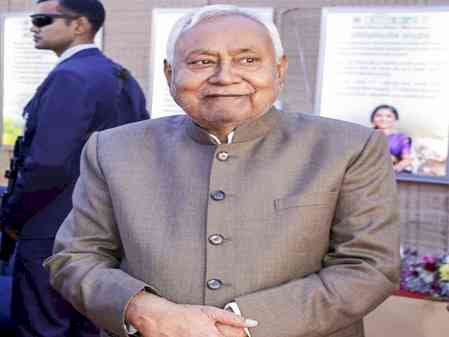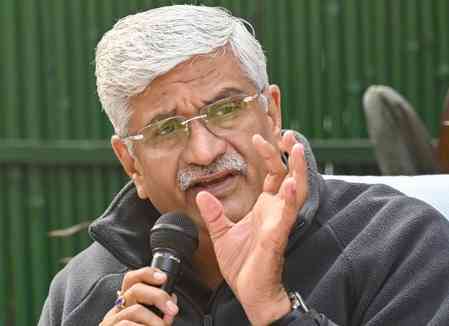Metabolism is Life
If anything, COVID19 has taught to humanity at large is that the value and worth of life is far more than any other material possession.

by Anugyan Sharma and Prof Pritam B Sharma
If anything, COVID19 has taught to humanity at large is that the value and worth of life is far more than any other material possession. Both the rich as well as the poor were seen running around for saving their lives during the pandemic which did not care whether you are from a developed or developing country, rich or poor, or race or religion. It treated the whole humanity as one and put it under a severe pressure of pandemic that swept the entire globe within no time. It took away over almost 6.3 million lives that included 10.1 lakhs in US, 5.25 lakhs in India, and 1.79 lakhs in UK among other countries. COVID19 pandemic also gave a wake up call for us to care more for our lives and the health of the environment and reminded us that if we do not mend our ways, pandemics will become part of life, that no one truly want.
It is here we need to now look after ourselves much more than our possessions, as the life is the most precious gift of God Almighty. We the humans, must be conscious of our responsibilities towards not only ourselves but also about the humanity at large and about the vast kingdom of God, this beautiful world of rich diversity that allows all creatures big and small, strong and the needy, everyone to have a right to live. The supremacy of man over all others that was somehow registered in our minds received for the first time, a major blow when the power of microbes has proved itself to be far more stronger than the power of all the guns and missiles, even the nuclear warheads. Till today, the fear of pandemic continues despite the vaccines doing a good job to overpower it to some extent by reducing its impact.
The Science of Life
It is here we need to look back at the science of life, that the famous writers of the early 20th century GP Wells, HG Well, and Julian Huxley presented in their highly thought-provoking book A science of life published in 1930. In their presentation of the science of life, they narrowed down their search for life to three main characteristics, namely mobility (ability to move), metabolism (ability to extract the vital energy and nutrients from the feed), and the ability to reproduce life to assure its sustenance. For it was quite clear to the scientists at the time that ‘life comes from life’. Of these metabolism holds an important place in our quest to nurture life and assure its sustenance in the body machine that we humans rejoice so well. The strength of our body, freshness of our mind, and the beauty of our soul that glows from our eyes and from our face, owes a lot to the health of our metabolism. Right from the day a child is born and grows, he needs a continuous supply of healthy food, beginning from mother’s milk feed to the healthy source of vitamins, fats, and nutrients from cereals, plants, and vegetables that should form the diet of a human being. The tremendous amount of energy that a healthy body and a healthy brain consumes requires a healthy metabolism that can breakdown the food in presence of air (pran vayu) and water into the vital energy and nutrients and also produce the necessary T-Cells to strengthen the immunity of the body organs to fight out any attacks from diseases and viruses from within or from outside.
Primary Functions of Metabolism
Metabolism performs three main functions in organisms as a set of life sustaining biological and chemical reactions: extracting the energy from food for cellular processes, conversion of food into the building blocks for biomolecules (proteins, nucleic acids, lipids, and carbohydrates), and finally, excreting metabolic waste such as nitrogen, carbon dioxide, water, and other substances that cannot be used by the organism once the metabolic processes occur.
Following the studies of GP Wells, HG Well, and Julian Huxley, metabolism is not only one of the three characteristics of life that are mentioned in their pathbreaking treatise but can also be seen as the process that allows for all other characteristics of life to happen. The reactions within metabolic processes allow the organisms to reproduce and respond through their environments through maintaining integrity in their structures, allowing for mobility. Metabolism also includes transportation of substances into and out of cells, further expanding on the importance of metabolism in mobility of an organism.
The types of reactions that occur in metabolism can simply be put into two terms: catabolic and anabolic. Catabolic reactions are ones which break down large substances into smaller ones to release energy, while anabolic reactions build (or synthesize) the simpler molecules into more complex ones such as proteins from amino acids, carbohydrates from sugars, fats from fatty acids. To sum it up, catabolism releases the energy while anabolism consumes the energy.
Metabolism in Humans, Plants and Animals
The processes of metabolism are not just exclusive to the human body, but rather metabolism just refers to the total biochemical reactions that take place in the body of an organism. Therefore, every living being has its metabolism, from the smallest bacteria to plants to animals to humans.
Metabolism in Plants
Glucose, the main sugar found in blood is made by plants by the process that we know as photosynthesis. In this, plants can use the energy derived from the sun to take carbon dioxide (which we exhale) and turn it into sugar molecules. Like humans, plants also require energy to undergo their cellular processes, so the plants use these sugars to power themselves. But at the same time, the sugar that is not used by plants is then turned into a food source for other animals to eat. When the plant is eaten, Adenosine TriPhosphate (ATP), the molecule which carries the energy into cells is synthesized to keep the respective cells running. In order words, the plants use energy from the sun to make sugars which are then to be consumed by animals.
Human Metabolic Rate vs that of Primates
For many years scientists believed that there is no difference in the speed at which humans and animals burned calories, however after more recent experiments in the last six years it’s been found that through questioning of the different proportions and actions of the body (such as a much larger brain size, and more ability to produce offspring) that there must be something which allows us to complete such tasks at much more efficient rates compared to animals such as primates.
Over the last two decades scientists have looked for these answers in different parts of the human body and have proposed multiple theories about the evolution that the human bodies have gone through which has caused an increase in energy efficiency. Leslie Aiello, president of the Wenner-Gren Foundation for Anthropological Research in New York City and her colleagues have proposed “that when our brains began to expand dramatically about 1.6 million years ago, our direct ancestor Homo erectus evolved a smaller gut that sucked up less energy Other teams suggested that humans reduced muscle mass to save energy; walked and ran more efficiently; or got extra calories faster by eating a higher quality diet, cooking food to cut down on the energy spent in digestion and sharing food. Indeed, there seemed to be no shortage of human adaptations that conserve energy.” (Gibbons, 2016)
In 2010, when researchers began to measure apes' total energy expenditures (TEEs) accurately for the first time, rather than just their resting rate. Orangutans and other primates had given surprising results – the fact that they have an unexpectedly low metabolic rate, according to Herman Pontzer of Hunter College in New York City.
Pontzer and primatologist Stephen Ross of the Lincoln Park Zoo in Chicago, Illinois, “set about measuring TEE directly in as many apes as possible at 14 zoos and two ape sanctuaries in the United States and Africa. They fed 27 chimps, eight bonobos, 10 gorillas, and 11 orangutans water labeled with certain isotopes of hydrogen and oxygen. Then they measured those two isotopes in the apes' urine to see how the ratio changed over time. The ratio reveals how much carbon dioxide the animal had generated, which reflects how many calories it had burned. The technique is the "gold standard" for metabolic studies, and the researchers did a "terrific job" using it to compare the total calories burned daily by apes and humans, says biological anthropologist William Leonard of Northwestern University in Evanston, Illinois.” (Gibbons, 2016)
The same methods were then used on 141 adults from five different countries around the world. After analyzing the data, the scientists found “that humans burn on an average 400 more calories per day than Chimps and Bonobos—635 calories more than Gorillas and 820 calories more than Orangutans. This meant that humans burned over 27% more energy per day on average than chimps.” (Gibbons, 2016) This study also asked questions about the different diets that are taken in by our different species, further generating a connection between what the ancient Hindu Vedic scholars had found to be Ahara, green food as one of the most important factors of life.
Human Metabolism and the Vegetarian Diet
It is no denying that we, the humans are born vegetarians who begin with mothers’ milk and have almost everything that they need for their healthy life from the plants and vegetables. The teeth and the shape of the jaw of human beings is also designed for a vegetarian diet as is the case for animals like cows, goats, elephants, horses, deer, and camels whose teeth and jaws resemble the human beings, unlike the carnivorous animals such as dogs, lions, tiger, foxes, and sharks. It is here we need to understand human metabolism in respect of the vegetarian diet. The plants, the cereals, fruits and vegetables offer a great combination of food for humans which together with milk and dairy products provide all that the metabolism of man requires to maintain a healthy body and a healthy mind. Studies have revealed that the vegetarian diets are associated with the higher metabolic rates. A study in Nutrients reported monitoring of the metabolic rates for 24 vegetarian and 26 non-vegetarian participants. It was found that vegetarians lowered their cholesterol levels, had higher levels of anti-inflammatory cytokines, and had higher metabolic rates, compared with nonvegetarians. The vegetarian diet derived from natural plant resources is easier to digest, as fruits and vegetables can easily transfer through the human body in less than 24 hours, in contrast to the two days that it takes for meat and fish. Naturally, the human metabolism is best suited for vegetarian diet. The milk and dairy products further strengthen the body and the mind by providing extra nutrients for building bones, as well as preventing diseases such as type two diabetes.
Vedic Sanatan Tradition for Healthy Life
In the Indian Vedic Sanatan tradition, the diet has also been considered to maintain the purity of mind and the righteous conduct of man that negates non-violence and cruelty towards animals and other creatures such as birds, fish, and reptiles. The right to live of man is also the right to live of animals and birds. We find the fullest of compliance to nonviolence, Ahimsa, in Jainism, where consumption of even plants that are to be uprooted, carrots, potatoes and onions is prohibited.
Today, when we are looking for lasting solutions for climate change, mitigating enormous amount of air and water pollution and engaged seriously in assuring a sustainable green future for the humanity at large, it becomes all the more important to pay a much greater attention to our metabolism and its nourishment using plants, fruits and vegetables and supplement them with milk and dairy products to assure good health of humanity as well as save our planet Mother Earth from avoidable sufferings and pains inflicted on animals for fetching our hunger.
---------------------------------------------------------------------------------------------------------------------
Anugyan is a 12th grader at an International School in the US, and Professor Pritam B Sharma is an eminent academician, former professor of IIT Delhi, founder Vice-Chancellor of DTU and RGPV, past president of Association of Indian Universities, AIU, and currently the Vice-Chancellor of Amity University, Gurugram.


 City Air News
City Air News 









